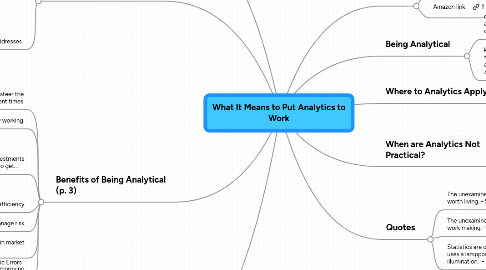
1. Gut Feel
1.1. 40% of major decisions are based not on facts, but on the manager's gut.
2. Benefits of Being Analytical (p. 3)
2.1. Help manage and steer the business in turbulent times.
2.2. Know what's really working.
2.3. Leverage previous investments in IT and information to get...
2.3.1. more insight
2.3.2. fast execution
2.3.3. more business value in business processes
2.4. Cut costs and improve efficiency
2.5. Manage risk
2.6. Anticipate changes in market conditions
2.7. Have a basis for improving decisions over time
3. Key Questions addressed by analytics
3.1. Great chart (p. 7)
3.2. dimensions
3.2.1. Time frame
3.2.1.1. past
3.2.1.2. present
3.2.1.3. future
3.2.2. Innovation
3.2.2.1. information
3.2.2.2. insight
3.3. questions addresses
3.3.1. information
3.3.1.1. past
3.3.1.1.1. What happened? (reporting)
3.3.1.2. present
3.3.1.2.1. What is happening now? (alerts)
3.3.1.3. future
3.3.1.3.1. What will happen? (extrapolation)
3.3.2. insight
3.3.2.1. past
3.3.2.1.1. How and why did it happen? (modeling, experimental design)
3.3.2.2. present
3.3.2.2.1. What's the next best action? (recommendation)
3.3.2.3. future
3.3.2.3.1. What's the best/worst that can happen? (prediction, optimization, simulation)
4. Typical Decision-Making Errors
4.1. Logic Errors
4.1.1. Not asking the right questions
4.1.2. Making incorrect assumptions and failing to test them
4.1.3. Using analytics to justify what you want to do instead of letting the facts guide you to the right answer
4.1.4. Failing to take the time to understand all the alternatives or interpret the data correctly
4.2. Process Errors
4.2.1. Making careless mistakes
4.2.2. Failing to consider analysis and insights in decisions
4.2.3. Failing to consider alternatives seriously
4.2.4. Using incorrect or insufficient decision-making criteria
4.2.5. Gathering data or completing analysis too late to be of any use
4.2.6. Postponing decisions because you're always dissatisfied with the data and analysis you already have
